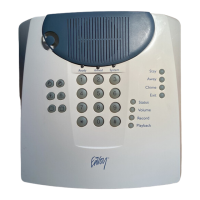
Do you have a question about the DSC Envoy NT9010 and is the answer not in the manual?
| Partitions | 2 partitions |
|---|---|
| Two-Way Wireless | Yes |
| Power Supply | 16.5V AC, 40VA |
| Zones | 8 hardwired zones, expandable |
| User Codes | Up to 48 |
| Siren Output | 12V DC |
| Keypad | Integrated |
| Communication | Cellular (optional), IP (optional) |
| Backup Battery | 12V |
| Operating Temperature | 0°C to 49°C |
| Humidity | 5% to 93% non-condensing |
Explains the system's components, operation, and monitoring capabilities.
Crucial safety warning about system limitations, responsibilities, and proper usage.
Information on monitoring fire conditions and installation requirements.
Instructions and importance of performing weekly system tests.
How the system communicates alarms and messages to a central station.
Basic care recommendations for the security system components.
How to check system status and use functions via the controller keypad.
Procedure to access the system using a telephone on the same premise line.
Procedure to access the system using a telephone not on the premise.
Instructions for recording and listening to voice memos via the controller.
How to arm the system when everyone is away from the premises.
How to arm the system when some occupants remain on the premises.
Using Quick Arm, No Entry, and Automatic Arming features.
Using the quick exit feature to leave while the system is armed.
Procedure for responding to and silencing fire alarms.
Procedure for responding to and silencing intrusion (burglary) alarms.
Using talk/listen-in features and checking alarm memory.
How to use Fire, Auxiliary, Medical, and Panic emergency keys.
Temporarily disabling detectors to avoid false alarms.
Identifying and addressing system faults, errors, and low battery warnings.
Procedures for performing weekly system operational tests.
Allowing installer access for system updates and diagnostics.
Adding, changing, or erasing user access codes and master codes.
Configuring the system's time and date for accurate operation.
Enabling or disabling the door chime feature for opened doors/windows.
Adjusting speaker and telephone prompt volume levels.
Checklist for assessing home fire safety conditions.
Developing and rehearsing a family fire escape plan.
Guidance on selecting and purchasing compatible batteries for system devices.
Responsibilities of installers regarding user warnings and system information.
Covers installation, criminal knowledge, power/battery failure, and wireless compromise.
Discusses limitations of smoke detectors, motion detectors, and warning devices.
Explains impact of telephone lines, time, component failure, testing, and insurance.
General cautions and FCC rules for device usage and modification.
Requirements for connecting to the telephone network and company notifications.
Information on REN and equipment maintenance facilities.